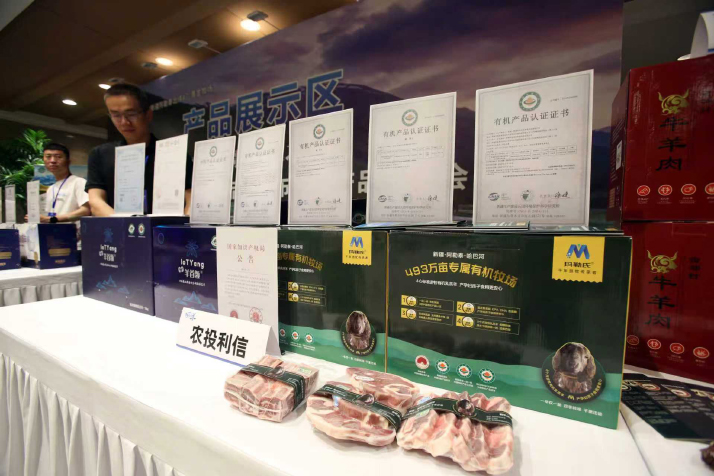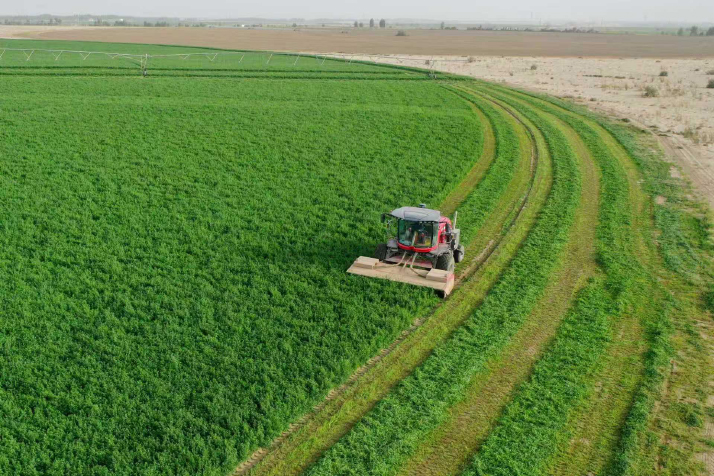| Xinjiang Today |
| What high-quality development means for Xinjiang | |
|
|
 Power transmission lines in Mulei Kazak Autonomous County, Changji Hui Autonomous Prefecture, on July 5 (XINHUA)
Achieving high-quality development is the central task in building a modern socialist country. Xinjiang plays a vital role in building a strong nation and achieving national rejuvenation.
Since the 18th National Congress of the Communist Party of China (CPC) in 2012, President Xi Jinping has provided the strategic direction to speed up high-quality development of China's border regions: "To govern the country well we must first govern the frontiers well." He has urged for efforts to develop border areas, improve the lives of the people there, and stabilize and solidify the borders.  A display of lamb products from Altay Prefecture at a product promotion event in Beijing on September 20 (XINHUA)
Xinjiang has successfully overcome its age-old problem of absolute poverty and together with the rest of the nation, has achieved moderate prosperity. In 2024, the region's GDP grew by 6.1 percent year on year, crossing the 2-trillion-yuan ($281 billion) mark. Trade has flourished, with total import and export reaching 400 billion yuan ($56 billion) in 2024, up from 300 billion yuan ($42 billion) in 2023. These accomplishments have laid a solid foundation for Xinjiang's economic and social advancement and provided a powerful momentum for continued progress. To build a new development pattern, drive high-quality development and advance Chinese-style modernization, Xinjiang should implement the new development philosophy of innovative, coordinated, green, open and shared growth. For that, it needs innovative development and new quality productive forces suited to local conditions. (New quality productive forces refer to advanced productivity that diverges from traditional growth models and development paths, characterized by high technology, high efficiency and high quality, and aligned with the new development philosophy—Ed.) Xinjiang should integrate scientific and technological innovation with industrial innovation, implement an innovation-driven development strategy, and improve its system and mechanisms for scientific and technological innovation. It should increase support for technological advancements, and stimulate and utilize the talent of its scientists and technologists to create new development drivers and advantages. The region's substantial mineral resources are a vital asset to drive economic growth and promote development. However, attention must be paid to avoid over-reliance on natural resources. Alongside exporting resources like coal and electricity, Xinjiang is cultivating strategic emerging industries, accelerating the digital economy's expansion and fostering new avenues for growth.  A machine harvests alfalfa at a planting demonstration base in Hetian (Hotan) County, Hetian Prefecture, on September 10. Besides providing a reliable source of fodder for local livestock, the cultivation of alfalfa, which has a deep root system, effectively combats desertification and protects the soil (XINHUA)
A significant achievement in 2024 was the completion and operation of the region's first intelligent computing center in the city of Karamay. Looking ahead, the focus on emerging economic frontiers must be honed. This means strategic planning to develop new quality productive forces and the comprehensive implementation of the AI Plus initiative, a national strategy to integrate AI in sectors such as industry, education and governance. Xinjiang is poised to accelerate the growth of nascent and future industries such as the low-altitude economy, green computing, the hydrogen energy industry, bio-manufacturing, quantum technology and commercial aerospace, thereby nurturing a new generation of innovative enterprises. Coordinated development and urban-rural integration should be prioritized. Coordinated development is a complex endeavor, requiring attention at multiple levels and across various aspects. At the national level, Xinjiang's high-quality development must be strategically planned within the larger vision of modernization. This means connecting with major regional development initiatives, such as the coordinated development of the Beijing-Tianjin-Hebei region, the Yangtze River Economic Belt and the Guangdong-Hong Kong-Macao Greater Bay Area. In parallel, the quality of paired assistance to Xinjiang must be elevated. This requires stronger scientific, educational, medical and industrial support. Internally, Xinjiang must prioritize integrated urban-rural development and people-centered new urbanization. Key initiatives include the establishment of the Urumqi Metropolitan Area, which encompasses Urumqi City, Changji Hui Autonomous Prefecture, Turpan City, Shihezi City, Wujiaqu City and Shawan City, with a total area of 175,500 square km. Centered around Urumqi, the Urumqi Metropolitan Area drives the integrated urban development of cities like Changji and Wujiaqu by strengthening inter-city industrial cooperation. To consolidate border security and prosperity, it is essential to strengthen the development of critical border towns and villages. Enhancing rural development is another priority. This involves thoroughly exploring unique rural resources, implementing brand-building strategies, fostering new rural industries and business models, and strengthening county-level economies. It also entails promoting integrated development across the primary, secondary and tertiary sectors in rural areas. These efforts will consolidate and expand the significant achievements in poverty alleviation. Xinjiang is committed to green development and becoming a "beautiful Xinjiang." Green development is an indispensable element of high-quality development. In recent years, Xinjiang has bolstered its efforts in ecological protection, leading to accelerated progress in green and low-carbon development. Another notable achievement in 2024 is the Kuche Economic and Technological Development Zone. There must be a focus on accelerating energy conservation and carbon reduction, along with upgrading energy-using equipment. Promoting clean, low-carbon, safe and efficient use of energy is critical. The aim is to improve urban and industrial wastewater recycling and expand green electricity trading. Simultaneously, Xinjiang will continue its commitment to protect and restore its ecological systems, and promote integrated management and conservation of its mountains, rivers, forests, fields, lakes, grasslands and deserts. It is also committed to open development and high-level opening up. Leveraging its significant geographical advantage, it has achieved remarkable success in expanding high-level opening up. In 2024, the core area of the Silk Road Economic Belt saw accelerated development, with cross-border China-Europe (Central Asia) freight trains increasing by 14 percent and notching up 16,400 trips. The China (Xinjiang) Pilot Free Trade Zone (FTZ) has also made substantial progress, implementing 129 reform tasks and generating 35 institutional innovations and best practices. Rapid implementation of the overall plan and reform tasks for the pilot FTZ is crucial. Xinjiang should also expand pragmatic cooperation with neighboring countries and regions, intensifying partnerships in areas like economy and trade, energy, science and technology, agriculture, and tourism. In addition, Xinjiang must champion shared development, ensuring that its development achievements equitably benefit all its ethnic groups. The aspiration to build a strong modern socialist country means no community can be left behind; similarly, advancing Chinese-style modernization demands that no border region is overlooked. At the heart of Xinjiang's high-quality development lies the imperative to improve people's lives and win their hearts. This requires dedication to addressing their pressing concerns and meeting their unmet expectations, which will elevate their sense of gain, happiness and security. For this, multiple strategies are needed to stabilize and expand employment, driven by an employment-first approach and supported by targeted plans for key regions, industries, urban and rural grassroots, and small and medium-sized enterprises. Particular attention should be given toward ensuring high-quality and full employment for key groups such as college graduates, rural laborers and those facing difficulties finding employment. Equally important is establishing a robust social security net, enhancing the social assistance system, and guaranteeing and securing basic livelihoods. Committed revitalization of rural areas will consolidate and expand poverty alleviation gains, preventing a relapse into poverty. Promoting high-quality development in Xinjiang is a systematic project. It demands full, accurate and thorough implementation of the CPC's strategy for governing Xinjiang in the new era, with the new development philosophy serving as the crucial guiding framework. A key priority is enhanced coordination of development with security, and opening up with security. To achieve this, reforms must be deepened comprehensively, high-level opening up expanded, and environments conducive to high-quality living created. Efficient innovation and governance must be fostered, and a high level of security guaranteed. Through these concerted efforts, significant strides will be made in the practice of Chinese modernization in Xinjiang. (Print Edition Title: A New Direction) The author is a researcher at the Institute of Chinese Borderland Studies, Chinese Academy of Social Sciences Comments to jijing@cicgamericas.com |
|
||||||||||||||||||||||||||||
|